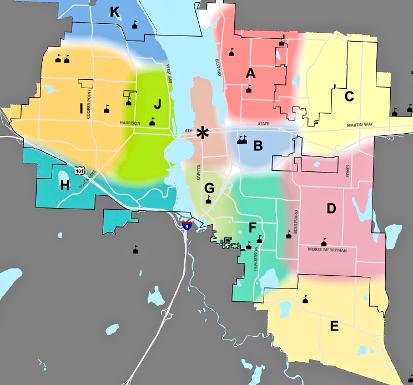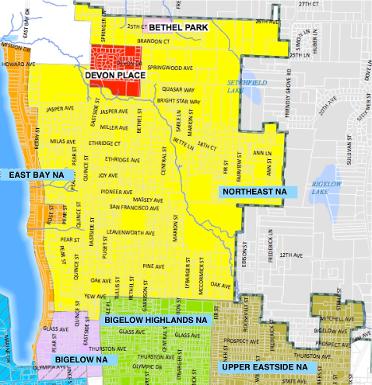ONNA is a alliance of 5 neighborhood associations in northeast Olympia (also called Sub-area A, below-left). We survey our residents, work together to identify our common needs, and help the City of Olympia make effective policy decisions for this area.
Who Are the Members of the ONNA Board?
Members are representatives of the 5 component neighborhood associations in Sub-Area A, and representatives of the City of Olympia. As of July 2015, members are:
Bigelow Neighborhood Association Laurie Dils
Bigelow Highlands Neighborhood Association Melissa Allen Angie Warner-Rein
East Bay Drive Neighborhood Association Don Law
Northeast Neighborhood Association Mike Dexel
Upper Eastside Neighborhood Association Teague Powell
City of Olympia Leonard Bauer
How Did ONNA Come About?
The 2014 Comprehensive Plan states, "Sub-area planning is conducted through a collaborative effort by community members and the City, and is used to shape how neighborhoods grow and develop". In February 2015, ONNA, formerly called the "A-Team" wrote an ONNA Letter to City Council, asking for specific direction in its duties. The council response (see response letter), set the following goals:
The Intent of Sub-area Planning is to:
• Collaborate with community members early in the planning process
• Help community members understand how they can impact neighborhood planning
• Influence community decisions that shape how neighborhoods grow and develop
• Help identify neighborhood assets, challenges and priorities for development
• Help community members understand plans and regulations that guide development in each area.
• Show how land-use decision-making processes work in accordance with federal, state and local laws
What are our concerns?
1. Public Safety (crosswalks, lighting, traffic mediation, public behavior, police relations)
2. Roads and Sidewalks (maintenance, needs, neighborhood impacts, efficiency)
3. Code Enforcement (abandoned cars, neglected houses, high noise and light levels)
4. Parks (maintenance, creation)
5. Beautification & Quality of Life (density, zoning, landscaping, cleanups, murals, public art)
6. Neighborhood Centers (developing them to suit our needs and promote sustainable living)
7. Create a sub-area plan, which can serve as a template for other Olympia Sub-Areas' organization
Facts about Subareas:
1. There are 12 subareas in Olympia
2. Sub-areas are about the size of an elementary school service area, with 5,000-10,000 residents
3. Sub-area boundaries don't always reflect neighborhood association boundaries
4. Each sub-area has its own needs, interests and processes for developing its respective plan.
5. Sub-area efforts must be consistent with the Comprehensive Plan
6. Sub-area strategies can address
- community health
- neighborhood centers and places of assembly
- streets and paths, cultural resources
- forestry and agriculture
- utilities
- open space and parks
- any other topic of interest to residents
7. Sub-area plans will not be adopted as part of the City's Comprehensive Plan, but will
- identify the neighborhoods' priority strategies and actions
- help the City prioritize its projects and programs
What will the Sub-Area Plans accomplish?
- Find creative ways to meaningfully engage a diversity of citizens to participate in planning
- Enable community partnerships to pool resources to efficiently and quickly create positive change
- Encourage collaboration between neighborhoods and City representatives
- Help define and influence the role that subareas play in City decisions and resource allocation

